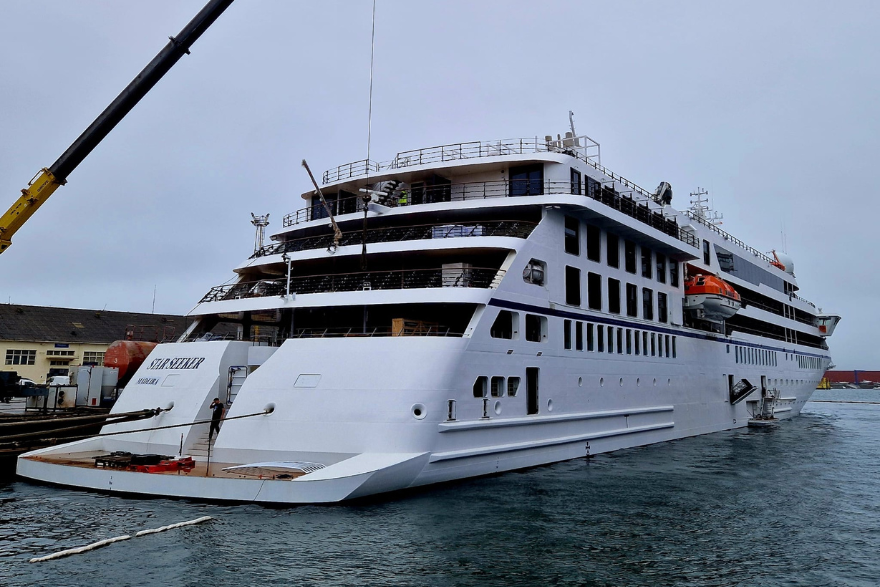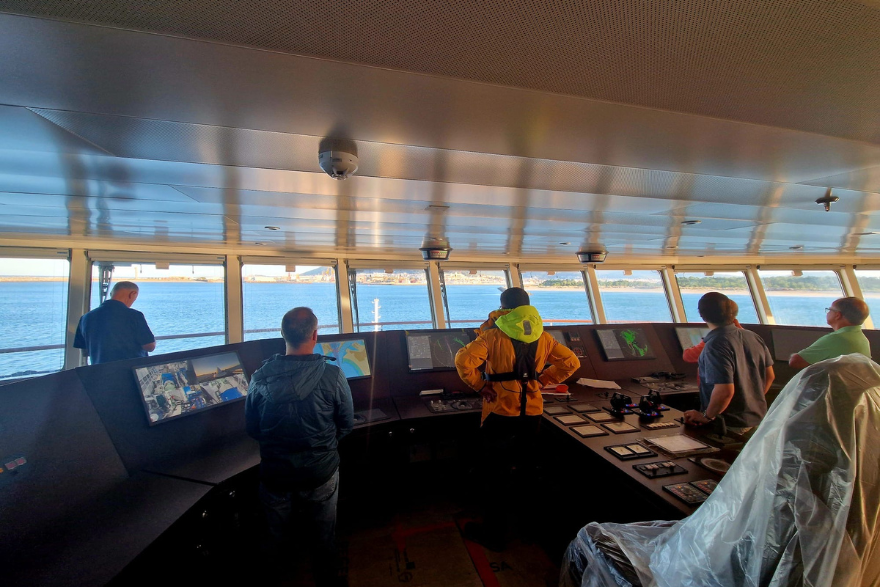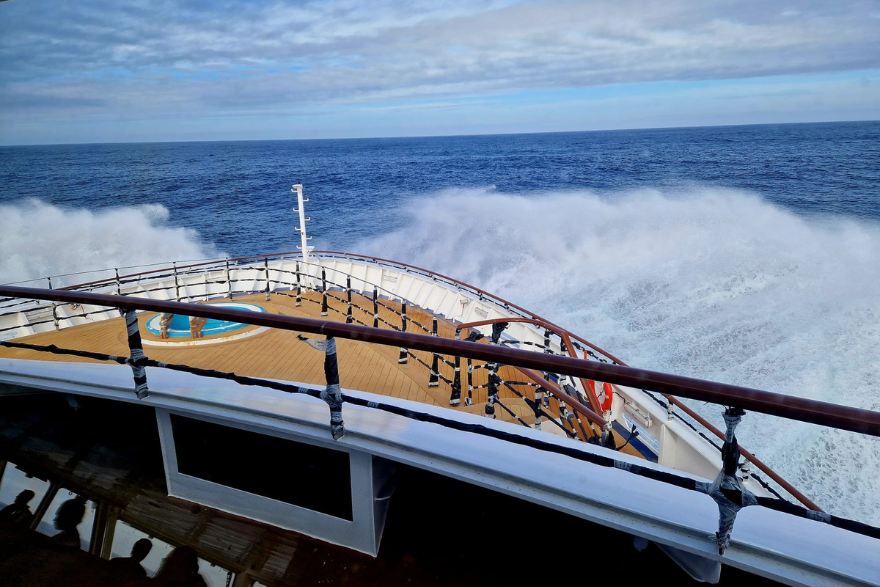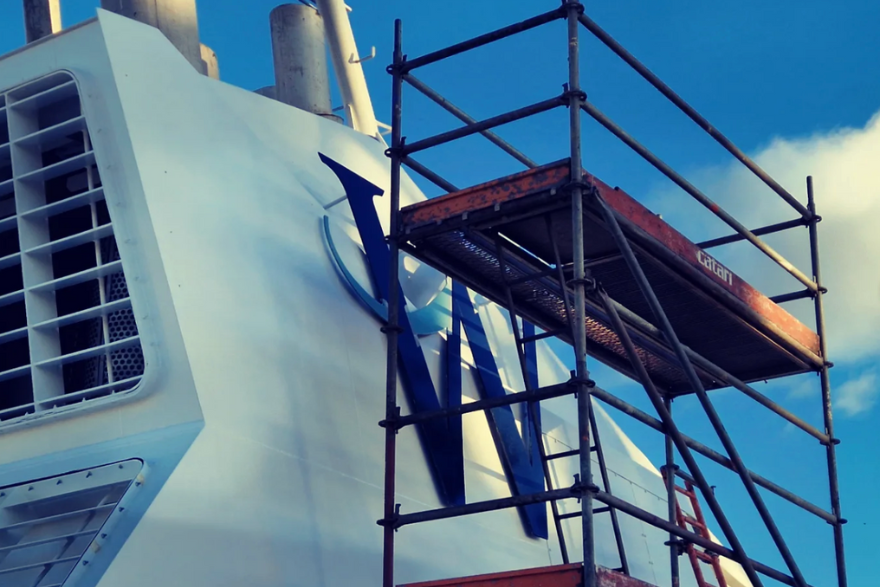As Star Seeker gets tantalizingly closer to launch (she debuts on December 28 in Malaga), we’ve heard a lot about “sea trials,” the next major milestone in the life of a newbuild. As we discovered from Star Seeker’s float-out, the moment when a ship takes to the sea and floats for the first time, there’s a definite purpose to sea trials. Star Seeker is being completed at WestSea Viana Shipyard, in Portugal.
“Sea trials are important because they give the shipbuilder and the owner a chance to see if the ship behaves and operates on the parameters that are agreed to in the ship’s contract,” says Teijo Niemela, editor and publisher of Cruise Business.com. “For instance, let’s say the contract specifies a ship’s maximum speed — the sea trial is where that will be tested.”

Indeed, says Windstar’s John Gunner, who participated in the ship’s out-to-sea maneuvers in early November. “We spent three days in the north Atlantic with a three-meter swell (almost ten feet), which is not ideal and yet she performed very, very well. Captain (Tom) Schofield was onboard and was given the opportunity to maneuver the ship, turning circle evaluation, crash stop tests and acceleration measurements. He was over the moon.
More specifically, the ship is tested in a number of different ways, all to make sure she is absolutely ready to sail. Among these?
Engine and Propulsion Testing: Engineers checked out Star Seeker’s engines, propulsion systems, and fuel consumption and assess how the ship performs at various speeds to ensure it can reach the required power and efficiency.
Navigation and Communication Systems: Making sure the ship’s navigation equipment (like radar, GPS, and communication systems) is functioning correctly.

Stability and Handling: How is the ship’s ability to handle various sea conditions (which is where the three-meter swells provided welcome challenges, Gunner tells us) including its turning radius, stability, and performance in rough waters.
Emergency Equipment: Safety procedures are tested, such as launching of lifeboats, and fire drills. We ensure that all safety equipment is easily accessible and watertight and fire doors are operational.
Systems and Equipment Check: All the onboard systems, including HVAC (heating, ventilation, and air conditioning), plumbing, electricity, and waste management, are checked to make sure everything works smoothly.
Passenger Comfort: The comfort and amenities provided for passengers, such as water systems, heating, cooling, and noise and vibration levels, are also monitored.
It’s a busy three days!
Sea Trials: it’s not all glamour

Even those of us who are not involved in the shipbuilding process but find it super interesting may be tempted to dream of experiencing sea trials. Gunner says it’s an intense, sometimes uncomfortable couple of days. Those present include Windstar’s Trevor Bailey, yard captain, the ship’s captain and chief engineer. Mystic engineers and yard workers are there, too, as are all of the contractors, such as engine manufacturers and automation suppliers, and all of the technicians who set up their systems onboard. Also present are members of the classification society.
“Sea trials is something to avoid unless you have to go. The ship is being moved around uncomfortably, testing steering and turning. It’s never a comfortable experience. If you don’t need to be there, you won’t want to be.”
One cool difference about Star Seeker’s performance in sea trials
Star Seeker’s design is, as we’ve noted in previous stories about the newbuild, based on a series of vessels that are currently operating as Atlas Ocean Voyages, all built for shipyard owner Mystic Invest. When Windstar acquired the platform, though, it made some significant changes to capture some of its iconic signature design features. One of these is her new stern, also called a ducktail.
“She’s a little different now because we have a new stern section, a ducktail. That design feature provides us with our iconic Marina platform, and it also has a damage stability benefit and hull efficiency impact,” Gunner says. “The previous ships in this series were measured at half a knot less max speed – and that’s because of the ducktail.”
What’s next?
Throughout November, the shipyard, Mystic and Windstar’s navigation, engineering and shipbuilding teams will continue to tweak operational systems, and mid-month, will receive its initial U.S. Coast Guard inspection. “This is in preparation for our first call in the U.S., which is in Miami in January,” Gunner says.
Now that Star Seeker is ship-shape, the big effort turns to hotel operations. “Now we’re getting the “hotel” ready for our guests,” he says. The next big step is to complete the hotel areas aboard, including outfitting, bulkheads, flooring, carpets, furnishings, and installation of entertainment systems. Crew members start joining around mid-November and early December. “They make beds, get trained on safety procedures and drills, and get used to their all-new home away from home.”
Windstar will take delivery of Star Seeker on December 15 and at that point ownership moves from the shipyard to the cruise line.
And then, there’s more….

Even before Windstar welcomes its first guests aboard Star Seeker, two shakedown cruises (think of them as dress rehearsals) will take place. The ship will reposition from PORTUGAL to Spain’s Malaga for the first, from December 18 -21. “The whole idea is to test it with actual guests,” he says. “This will be the time when 100 people are all having a shower at the same time – and you know the pumps are working.”
“The stress testing continues on December 21st,” Gunner tells us. “We want to make sure that everything is working properly for a longer voyage.
Look,” he says, “it’s well worth the investment and cost of effort to make sure Star Seeker is as she should be before our valued guests come onboard.”
Stay tuned as we’ll be reporting on the blog from the December 21st sailing.
Star Seeker’s first revenue cruise, a 16-night Atlantic crossing that sails from Malaga to Miami, departs on December 28. The ship will be christened in Miami on January 15, 2026. Its maiden season itineraries will visit the Caribbean, Panama Canal and Latin America, U.S. West Coast, Alaska, and Japan.




















































